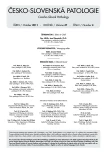Gastrointestinal stromal tumor molecular diagnostics in relation to the prediction of a therapeutic response to targeted biological therapy
Authors:
A. Augustiňáková; R. Kodet
Authors‘ workplace:
Ústav patologie a molekulární medicíny, 2. LF UK a FN Motol, Praha
Published in:
Čes.-slov. Patol., 47, 2011, No. 4, p. 148-152
Category:
Reviews Article
Overview
Targeted therapy based on the inhibition of the receptor tyrosine kinases has improved the outcome of patients with metastatic, recurrent and/or unresectable gastrointestinal stromal tumors (GIST). Activating mutations of KIT and PDGFRA genes, which code for receptor tyrosine kinases, play an important role in the malignant transformation of stromal cells in the gastrointestinal tract. The response to targeted therapy is associated with the presence and type of mutations. Molecular identification of the primary mutational status became an important tool in predicting the response to therapy (sensibility/resistance). The identification of secondary mutations occurring in patients treated with targeted therapy may explain the cause of acquired, secondary resistance of GIST. In these cases, mutational analysis represents a tool to explain failure of the therapy and provides a rationale for alternative therapeutic strategies.
Keywords:
GIST – receptor tyrosine kinases – KIT – PDGFRA – targeted therapy – molecular analysis
Sources
1. Heinrich MC. Molecular basis for treatment of gastrointestinal stromal tumours. EJC Supplements 2006; 4(1): 10–18.
2. Joensuu H. Current perspectives on the epidemiology of gastrointestinal stromal tumours. EJC Supplements 2006; 4(1): 4–9.
3. Rubin BP. Gastrointestinal stromal tumours: an update. Histopathology 2006; 48(1): 83–96.
4. Dirnhofer S, Leyvraz S. Current standards and progress in understanding and treatment of GIST. Swiss Med Wkly 2009; 139(7–8): 90–102.
5. Miettinen M, Lasota J. Gastrointestinal stromal tumors: review on morphology, molecular pathology, prognosis, and differential diagnosis. Arch Pathol Lab Med 2006; 130(10): 1466–1478.
6. Miettinen M, Sarlomo-Rikala M, Lasota J. Gastrointestinal stromal tumors: Recent advances in understanding of their biology. Hum Pathol 1999; 30(10): 1213–1220.
7. Chen LL, Holden JA, Choi H, et al. Evolution from heterozygous to homozygous KIT mutation in gastrointestinal stromal tumor correlates with the mechanism of mitotic nondisjunction and significant tumor progression. Mod Pathol 2008; 21(7): 826–836.
8. Augustiňáková A, Kodet R. Histopatologická a molekulární charakteristika a diagnostika gastrointestinálních stromálních tumorů. Farmakoterapie (speciální příloha: Aktuální pohled na léčbu GIST) 2010; 6–13.
9. Daum O, Vaněček T, Šíma R, et al. Gastrointestinální stromální tumor: Současný pohled. Klinická onkologie 2006; 19(4): 201–211.
10. Daum O, Vaněček T, Michal M. Patologická diagnostika gastrointestinálního stromálního tumoru. Onkologie 2010; 4(1): 13–17.
11. Plank L. Bioptická diagnostika gastrointestinálnych stromálnych nádorov. Onkologie 2007; 1(2): 73–78.
12. Miettinen M, Sobin LH, Lasota J. Gastrointestinal stromal tumors of the stomach: a clinicopathologic, immunohistochemical, and molecular genetic study of 1765 cases with long-term follow-up. Am J Surg Pathol 2005; 29(1): 52–68.
13. Miettinen M, Lasota J. Gastrointestinal stromal tumors-definition, clinical, histological, immunohistochemical, and molecular genetic features and differential diagnosis. Virchows Arch 2001; 438(1): 1–12.
14. Fletcher CD, Berman JJ, Corless C, et al. Diagnosis of gastrointestinal stromal tumors: A consensus approach. Hum Pathol 2002; 33(5): 459–465.
15. Wardelmann E, Hrychyk A, Merkelbach-Bruse S, et al. Association of plateled-derived growth factor receptor alpha mutation with gastric primary site and epitheloid or mixed cell morphology in gastrointestinal stromal tumors. J Mol Diagn 2004; 6(3): 197–204.
16. Burger H, den Bakker MA, Kross JM, et al. Activating mutation in c-KIT and PDGFRalpha are exclusively found in gastrointestinal stromal tumors and not in other tumors overexpressing these imatinib mesylate target genes. Cancer Biol Ther 2005; 4(11): 1270–1274.
17. Penzel R, Aulmann S, Moock M, et al. The location of KIT and PDGFRA gene mutations in gastrointestinal stromal tumors is site and phenotype asociated. J Clin Pathol 2005; 58(6): 634–639.
18. Breccia M, Alimena G. The metabolic consequences of imatinib mesylate: Changes on glucose, lypidic and bone metabolism. Leuk Res 2009; 33(7): 871–875.
19. Heinrich MC, Corless CL, Demeteri GD, et al. Kinase mutations and imatinib response in patients with metastatic gastrointestinal stromal tumor. J Clin Oncology 2003; 21(23): 4342–4349.
20. Antonescu CR. Targeted therapy of cancer: new roles for pathologists in identifying GISTs and other sarcomas. Mod Pathol 2008; 21(Suppl 2): S31–36.
21. Hirota S, Isozaki K. Pathology of gastrointestinal stromal tumors. Pathol Int 2006; 56(1): 1–9.
22. Blay JY, Reichardt P. Advanced gastrointestinal stromal tumor in Europe: a review of updated treatment recommendations. Expert Rev Anticancer Ther 2009; 9(6): 831–838.
23. Samelis GF, Ekmektzoglou KA, Zografos GC. Gastrointestinal stromal tumor: clinical overview, surgery and recent advances in imatinib mesylate therapy. Eur J Surg Oncol 2007; 33(8): 942–950.
24. Hornick JL, Fletcher CD. The role of Kit in the management of pacients with gastrointestinal stromal tumor. Hum Pathol 2007; 38(5): 679–687.
25. Gupta P, Tewari M, Shukla HS. Gastrointestinal stromal tumor. Surg Oncol 2008; 17(2): 129–138.
26. Linke Z, Prausová J, Kubáčková K. Pokroky v léčbě gastrointestinálního stromálního tumoru. Farmakoterapie 2007; 3(4): 373–381
Labels
Anatomical pathology Forensic medical examiner ToxicologyArticle was published in
Czecho-Slovak Pathology

2011 Issue 4
Most read in this issue
- Carney complex
- Predictive diagnosis of HER2 in gastric adenocarcinoma
- Giant cutaneous basal cell carcinoma of the head with intracranial propagation – a case report
- Acatholytic Variant of Squamous Carcinoma of the Breast. A Case Report and Review of Literature
